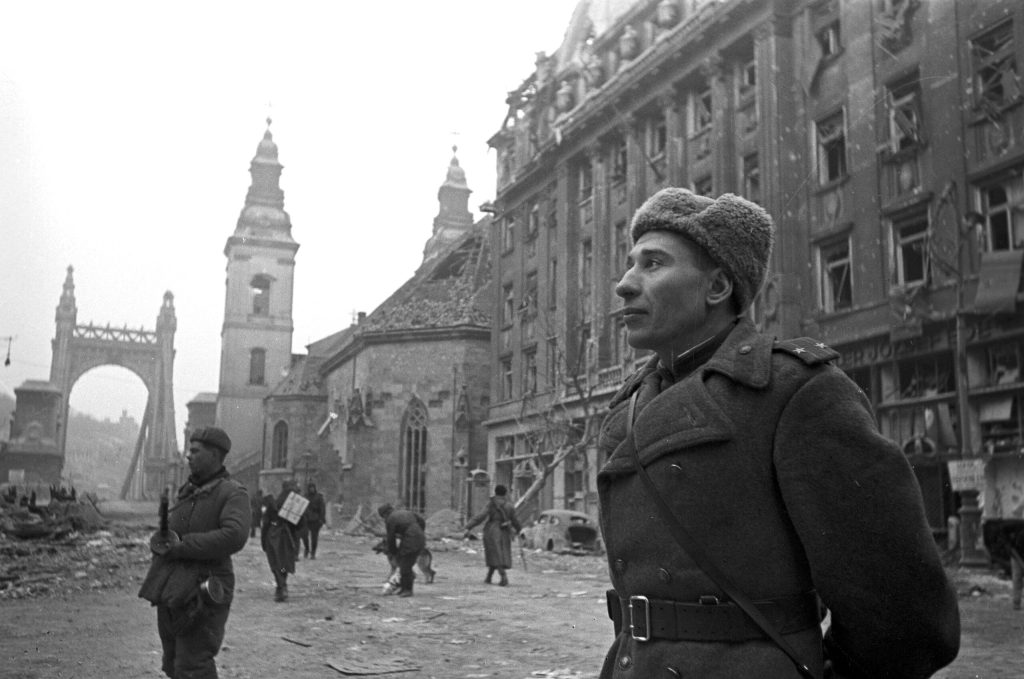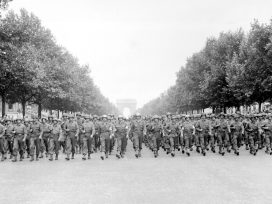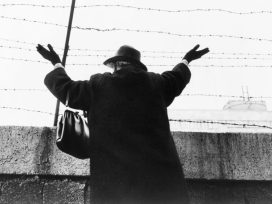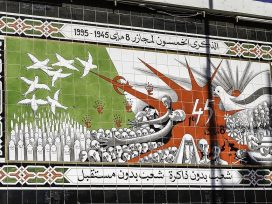The remembrance of the Second World War has shifted significantly in recent decades – and even more dramatic reinterpretations appear to be underway in our current moment of drastic uncertainty.
More than three years since Russia launched its full-scale war against Ukraine, with the far right achieving several notable successes within the EU and beyond, the historical and ideological core of the confrontation in the post-Soviet parts of the continent deserves urgent attention. Although it has multiple sources, this growing confrontation continues to gravitate around divergent interpretations of the Second World War and – crucially – the meanings assigned to its outcome and consequences.
If Ernst Nolte’s seeming equation of the crimes committed by the Soviet and Nazi regimes were widely rejected as ‘revisionist’ in the Federal Republic of Germany back in the mid-1980s, comparable nationalistic stances – in which uncompromising forms of anti-communism helped obscure local histories of rightwing authoritarianism and extremism – became part of the mainstream in the Baltic states and elsewhere in the post-Soviet space after 1991. Political and cultural elites of these newly independent states soon began to insist on the ‘equal criminality’ of what they called the two totalitarian dictatorships of the twentieth century. Recently liberated from Moscow’s hegemony, these states could be said to have been ‘revisionist from almost the very beginning.’
Their increasingly hegemonic perspectives clashed with the canonical vision of the Great Patriotic War in Russia. Via the already widespread idea of ‘twin totalitarian regimes’, they also came to influence the European Union, which particularly after enlargement became an important player in the field of history politics. The bloc was now willing to accommodate such nationalistic views in a spirit of ‘principled pragmatism’.

Scenes in central Budapest after the Soviet victory in the battle for the city from December 1944–February 1945. Image: Fortepan / Source: Wikimedia Commons
In 2008, the European Parliament declared 23 August as the European Day of Remembrance for Victims of Stalinism and Nazism. In similar vein, the House of European History, the Parliament’s museum in Brussels that opened in 2017, depicts the inter-war years as a battle between totalitarianism and democracy. In adopting a chronological narrative that referenced the Communist dictatorship and Stalin cult before discussing Nazism, the museum’s intention may not have been to alienate Russian visitors; but such an effect was hardly unforeseeable.
The equation of Stalinism and Nazism, and the consequent reinterpretation of their epochal war between 1941 and 1945 as a devastating confrontation between twins, could simply be viewed as a rightward shift in the European mainstream since 1989–91.
However, memory change has been more multilayered and ambiguous than that. As our young century has amply demonstrated, we are in fact confronted with two revisionisms that are at play simultaneously – the one anti-totalitarian, which equates rather than compares; the other antifascist, replicating the worst abuses of the Soviet era, when practically any political opponent could be labelled fascist.
Central and eastern Europeans have been eager to reinterpret the outcome of the Second World War through the concept of sovereignty, which they deploy to describe their experience of continued oppression and belated liberation after 1945. This has culminated in the notion that only the events of 1989–91 unmade the direct consequences of the Second World War.
Putin’s Russia, on the other hand, has been increasingly committed to a staunchly nationalistic victimhood-to-victory narrative, while also attempting to take violent revenge for what it understands as the ‘enlargement of the western sphere of influence’ after the conclusion of the Cold War.
The widening gap between these two revisionisms deserves to be emphasized, not least because political agendas have increasingly replaced professional discourses by historians across Europe, threatening to marginalize more research-based, nuanced perspectives. Vladimir Putin’s ‘essay’ on the historical unity of Russians and Ukrainians, published in 2021, is only the most infamous example of a wider trend.
The anti-totalitarian reinterpretation has rendered post-Cold War central and eastern Europe similar to western Europe during the Cold War. There is a strong sense of déjà vu in today’s conviction that European states need NATO, and especially the United States, to provide a protective shield against the Kremlin’s sinister intentions and expansionist policies. This same conviction is today giving rise to profound fears among central and eastern Europeans, or at least those committed to the political project of the West, that they might again turn out to be much less fortunate than their western European counterparts.
But if Russia under Putin is a radical revisionist power that wants to undo the outcome of the Cold War and restore the ‘might and glory’ of the Russian Empire, the end of the Soviet Union should also serve as a warning to it that imperial overstretch can prove fatal. The Sovietization of Poland and Hungary after the Second World War is important here. These were, after all, the same states that first exited communist single-party rule in 1989, and whose exit had an unexpected domino effect. More important still is the recent past of the Baltic states and western Ukraine, where the movements originated that ultimately led to the collapse of the USSR in 1991. In other words, the notorious secret protocols of the Molotov-Ribbentrop Pact of 1939 also contained the seeds of imperial overstretch.
This introduces another dimension to the political fractures of the present, one that historians of central and eastern Europe have been both fascinated and puzzled by. It concerns the difference between the northern (or north-eastern) and southern (or south-western) parts of this diverse region.
The northern states (including Romania) affected directly by the Molotov-Ribbentrop Pact, which across the centuries have also had more extensive experience with Russian imperialism, are today at the forefront of western opposition to Russia’s revanchist ambitions. That is not surprising.
Less obvious, however, is why south-western states such as Slovakia, Hungary and Serbia are today among the most equivocal in Europe when it comes to Russia’s brutal war of aggression against Ukraine. The fact that they were not targeted by the Molotov-Ribbentrop Pact and its secret protocol should certainly be part of any explanation of that ambiguity, but no more than a part.
It appears that, in the current context of neo-imperialist aggression, exposure to imperial rule and mass violence in the recent and not-so-recent past has given rise to either opposition or hedging. While the various actors in central and eastern Europe agree that occupation and foreign domination should never happen ‘to us’ again, the strategies they adopt to achieve that objective diverge sharply. The connection between this bifurcation of central and eastern Europe and the two kinds of experiences gathered in 1939–41 still needs to be properly accounted for.
Taking a committed stance against the aggressor is clearly necessary, of course. But any serious discussion of western responsibility needs to consider that supporting Ukraine in resisting Russia’s brutal onslaught contributes in a secondary manner to the devastation of Ukrainian – and Russian – lives. We need to confront the possibility that painful trade-offs exist between democracy and autonomy, on the one hand, and peace and human life, on the other. But currently, the most urgent – and perhaps not fully answerable – challenge for the West remains how to craft a genuine strategy of peace that does not collude with Russian interests at all.
I write this in late April 2025 under conditions of grave uncertainty. The most immediate causes of that uncertainty are, of course, Donald Trump’s utterly reckless and disturbing start to his second term as US president, and the much-feared prospect of rapprochement between the two main Cold War superpowers, which could come at the expense of Ukrainians and Europeans more generally. Such a radically new future would likely mainstream new perspectives on the past.
But when it comes to the future of history politics in central and eastern Europe, there is another significant reason for our current uncertainty: the crisis of German memory culture. Due primarily to the manifold efforts of its civil society, no country has succeeded more than the Federal Republic in building a (post-)national identity based on remembrance of the ‘sins of the fathers’. That self-critical template has been received, recurrently debated, and quite often rejected by central and eastern Europeans in recent decades.
The canonical German remembrance of the Second World War has revolved around honouring the principal victims of German wartime aggression and Nazi genocidal policies, most notably Jews and Soviet citizens. But we now know that being especially sensitive and, one might argue, permissive towards the subsequent political projects of the main groups victimized by the Nazis, above all the Russian Federation and the State of Israel, can be in glaring contradiction with commitments to basic universal norms.
For many, the author included, one of the most painful realizations of recent years has been just how profound this contradiction can be. That is no reason to reject the self-critical template at the heart of German memory culture. But it certainly calls for an urgent examination of its less than salutary political effects. If the ‘German model’ of remembrance can lead to such moral and political cul-de-sacs, what can we hope for from central and eastern Europe’s increasingly nationalistic and fearful peoples?
Any answer to that question will depend on future global political dynamics and their impacts on the region. What seems clear, at any rate, is that the Second World War will continue to be a key landmark for central and eastern Europeans desperately looking for orientation in an increasingly bewildering world.







